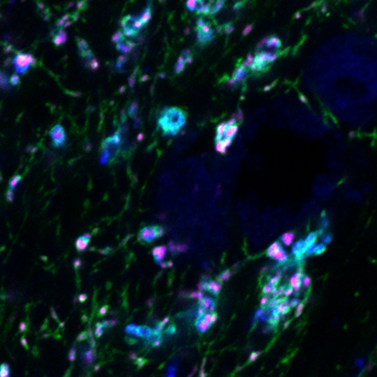By Jasmine Reggiani, Mark Andermann, and Chinfei Chen
Our perception of the world arises from streams of sensory information that enter the brain and is shaped by internal states such as hunger, fear, and arousal. In the case of vision, parallel channels relay information regarding features such as luminance, motion, or fine details. Internal states act on sensory information through neuromodulators such as serotonin, which can determine whether this information is relayed to downstream brain regions for further processing. We wondered whether serotonin could affect sensory processing at an early stage in the visual processing hierarchy, and whether such actions can lead to selective relaying of information regarding certain visual features more than others. To address these questions, we used two-photon calcium imaging in awake behaving mice to track the activity of individual retinal axons as they relay visual signals to the thalamus. At the same time, we increased natural release of serotonin in the thalamus via optogenetic stimulation of brainstem serotonergic axons entering the thalamus.

The image shows serotonin receptor expression on retinal axon terminals in the thalamus. Retinal axons are shown in green, the presynaptic terminals are shown in blue and the serotonin receptors in magenta.
We found that serotonin suppresses retinal axon presynaptic calcium signals and glutamate release in the thalamus, thereby decreasing transmission of signals from the eye to the thalamus. Interestingly, different retinal axon classes were more strongly suppressed by serotonin: ones that responded strongly to large-scale changes in luminance were more suppressed than those responding to fine detail. We compared this selective modulation to that seen during states of high arousal, a state in which retinal inputs to the thalamus are also differentially suppressed. We found that periods of high arousal, but not increases in serotonin release, more strongly suppressed retinal channels relaying information about fine details in the visual scene.
We wanted to understand how serotonin may be selectively modulating some retinal axons but not others. We find that this is not due to differences in density of serotonin axons near different classes of retinal terminals, but rather may be due to differences in expression of a specific serotonin receptor on different retinal terminals. Together, these findings suggest that different internal states can select which visual information to filter, altering sensory perception in different ways to guide relevant behavior. The actions of serotonin at this very early stage of visual processing may ensure that only the visual information that is relevant during a given brain state is relayed to thalamus and cortex.
Jasmine Reggiani is a graduate student in the labs of Mark Andermann and Chinfei Chen
Mark Andermann is Professor of Medicine at Harvard Medical School
Chinfei Chen is Professor of Neurology at Harvard Medical School and a Research Associate in Neurology, Boston Children’s Hospital
Learn more the in original research article:
Brainstem serotonin neurons selectively gate retinal information flow to thalamus.
Reggiani JDS, Jiang Q, Barbini M, Lutas A, Liang L, Fernando J, Deng F, Wan J, Li Y, Chen C, Andermann ML. Neuron. 2022 Dec 21:S0896-6273(22)01079-0. doi: 10.1016/j.neuron.2022.12.006. Epub ahead of print. PMID: 36584680.
News Types: Community Stories
